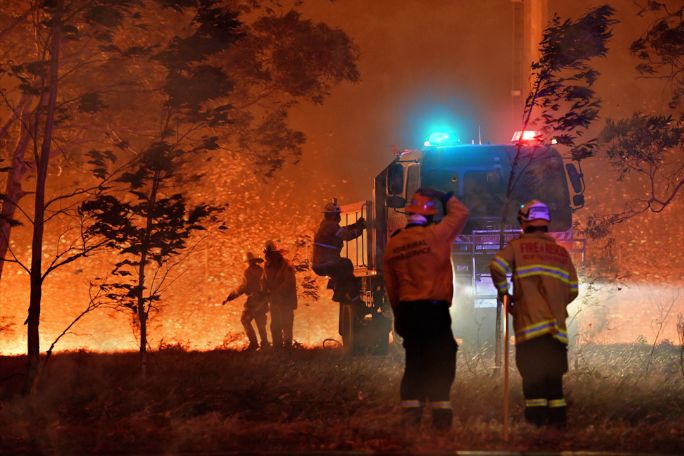Lesson summary
What happens when you’re faced with a crisis? Do you lose hope, or are you stronger for it?
In this lesson, students view the feature documentary “A Fire Inside”, a documentary about the most catastrophic fires to have swept through our land in Australian history.
Through media integration, students are supported to connect the film to their understanding of the themes of resilience, hope, rebuilding and community.
Learning intentions:
Students will...
- connect with priorunderstanding of the key themes in the film
- identify, share and learn strategies for remaining emotionally safe when exploring challenging content
- make connections between characters and themes within a film
Success criteria:
Students can...
- connect with their prior knowledge about hope, resilience and community building
- take notes on key themes and characters as they watch a film
- find connections between characters and a film
- draw upon taught and known strategies for staying emotionally safe
Lesson guides and printables
Curriculum links
Select your curriculum from the options below.
Lesson details
Curriculum mapping
Australian curriculum content descriptions:
Year 7 English:
- Reflect on ideas and opinions about characters, settings and events in literary texts, identify areas of agreement and difference with others and justify a point of view (ACELT1620)
Year 8 English:
- Share, reflect on, clarify and evaluate opinions and arguments about aspects of literary texts (ACELT1627)
- Understand and explain how combinations of words and images in texts are used to represent particular groups in society, and how texts position readers in relation to those groups (ACELT1628)
Year 9 English:
- Explore and reflect on personal understanding of the world and significant human experience gained from interpreting various representations of life matters in texts (ACELT163)
- Explore and reflect on personal understanding of the world and significant human experience gained from interpreting various representations of life matters in texts (ACELT1635)
Year 10 English:
- Evaluate the social, moral and ethical positions represented in texts (ACELT1812)
- Use comprehension strategies to compare and contrast information within and between texts, identifying and analysing embedded perspectives, and evaluate supporting evidence (ACELY1754)
Year 9 & 10 HPE:
- Evaluate factors that shape identities and critically analyse how individuals impact the identities of others (ACPPS089)
Year 10 Science:
- Values and needs of contemporary society can influence the focus of scientific research (ACSHE230)
- Global systems, including the carbon cycle, rely on interactions involving the biosphere, lithosphere, hydrosphere and atmosphere (ACSSU189)
Syllabus outcomes: En5-2A
Syllabus outcomes: PDHPE5.1
Syllabus outcomes: SC5-11PW, SC5-12ES
General capabilities: Literacy, Intercultural Understanding
Cross-curriculum priority: Sustainability
Relevant parts of Year 7 English achievement standards:
By the end of Year 7, students understand how text structures can influence the complexity of a text and are dependent on audience, purpose and context. They demonstrate understanding of how the choice of language features, images and vocabulary affects meaning.
Relevant parts of Year 8 English achievement standards:
By the end of Year 8, students understand how the selection of text structures is influenced by the selection of language mode and how this varies for different purposes and audiences. Students explain how language features, images and vocabulary are used to represent different ideas and issues in texts.
Relevant parts of Year 9 English achievement standards:
By the end of year 9, students evaluate and integrate ideas and information from texts to form their own interpretations. They select evidence from texts to analyse and explain how language choices and conventions are used to influence an audience. They listen for ways texts position an audience.
Relevant parts of Year 10 English achievement standards:
By the end of year 10, students show how the selection of language features can achieve precision and stylistic effect. They explain different viewpoints, attitudes and perspectives through the development of cohesive and logical arguments. They develop their own style by experimenting with language features, stylistic devices, text structures and images.
Resources required
- A device capable of presenting a video to the class
- Blank A3 or larger paper – enough for several small groups
- Post-it notes, whiteboard and markers
- Student Worksheet – one copy per student
Skills
This lesson is designed to build students’ competencies in the following skills:
- Communication
- Cultural understanding
- Community engagement
- Critical thinking
- Empathy
- Ethical understanding
- Social skills
- Problem solving
Additional info
Before teaching the lessons, ensure you have watched the feature documentary ‘A Fire Inside’, rated MA15+ and have gained approval from parents and guardians before viewing the documentary.
To view the film you can rent or purchase an online copy from Google Play, Apple TV, Prime Video, or Ritz at home.
Students may develop heightened emotions and discomfort during the film whilst learning about the psychological effects and impact the fires had on animals, people, families, communities, and the country. It is recommended that you direct students to a school counsellor if they require additional support and read through the Handling Sensitive Topics and Issues: Handling Sensitive Topics and Issues.
About the feature documentary - A Fire Inside:
When a volunteer firefighter drives his car to almost certain death, he does it during the worst fires in Australian history because he ‘has a job to do’. Three months later, the fires are out, but his fight is just beginning.
Turning a sensitive lens on the unprecedented devastation of Australia’s 2019/2020 ‘Black Summer’ bushfires; from a country-wide emergency to the astonishing stories of help that emerged, A Fire Inside presents an inspirational look at how people respond to crisis and the impact it has on the human spirit.


Welcome back!
Don't have an account yet?
Log in with:
Create your free Cool.org account.
Many of our resources are free, with an option to upgrade to Cool+ for premium content.
Already have an account?
Sign up with:
By signing up you accept Cool.org's Terms and Conditions(Opens in new tab) and Privacy Policy(Opens in new tab).